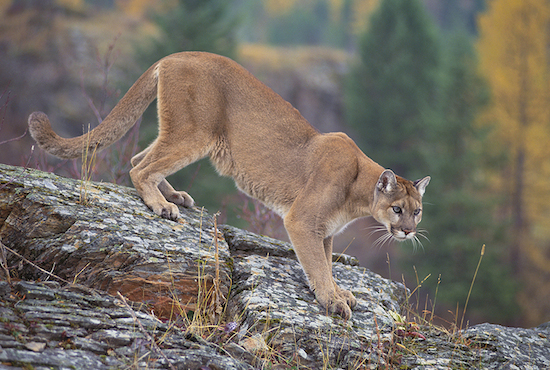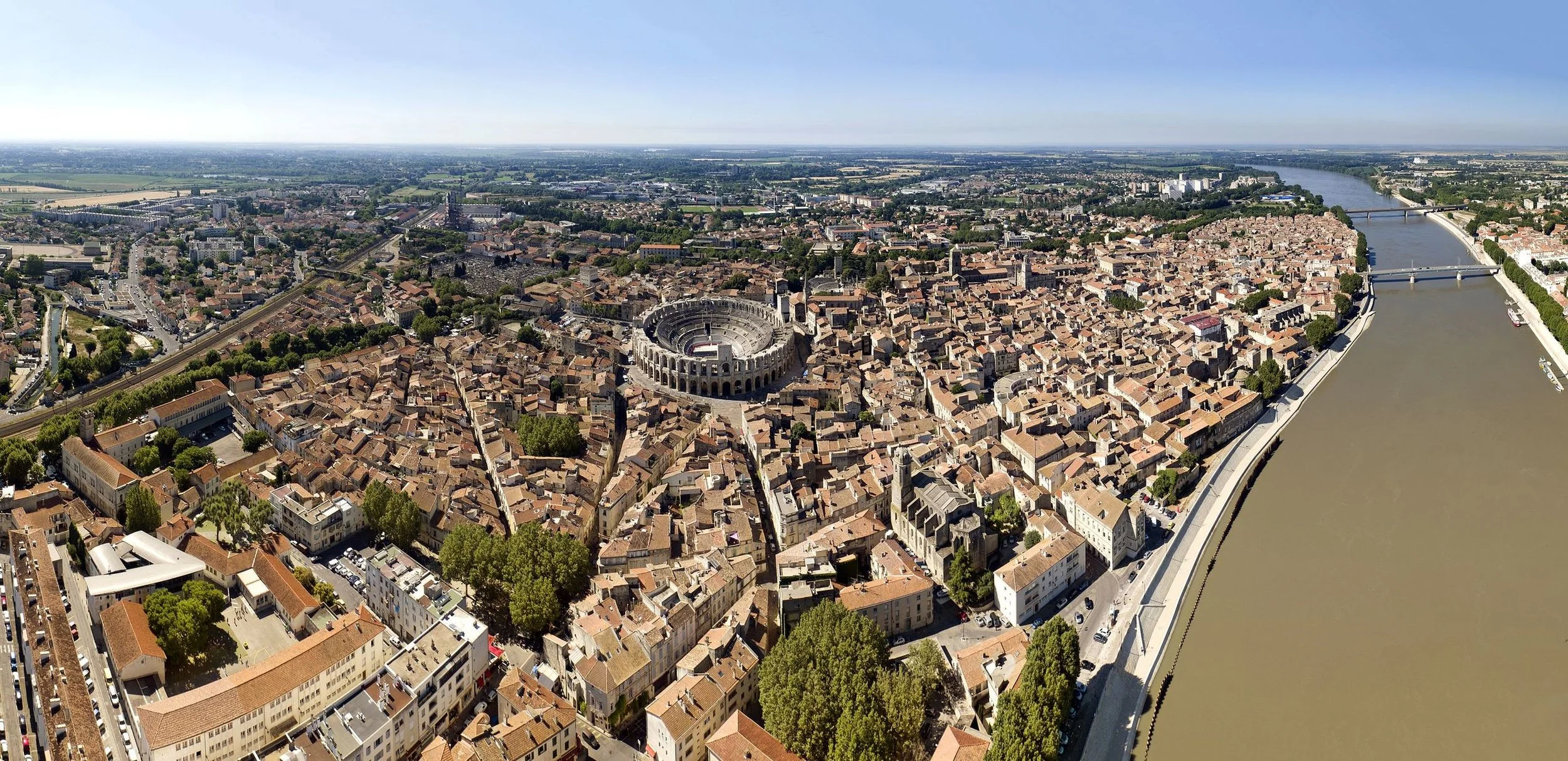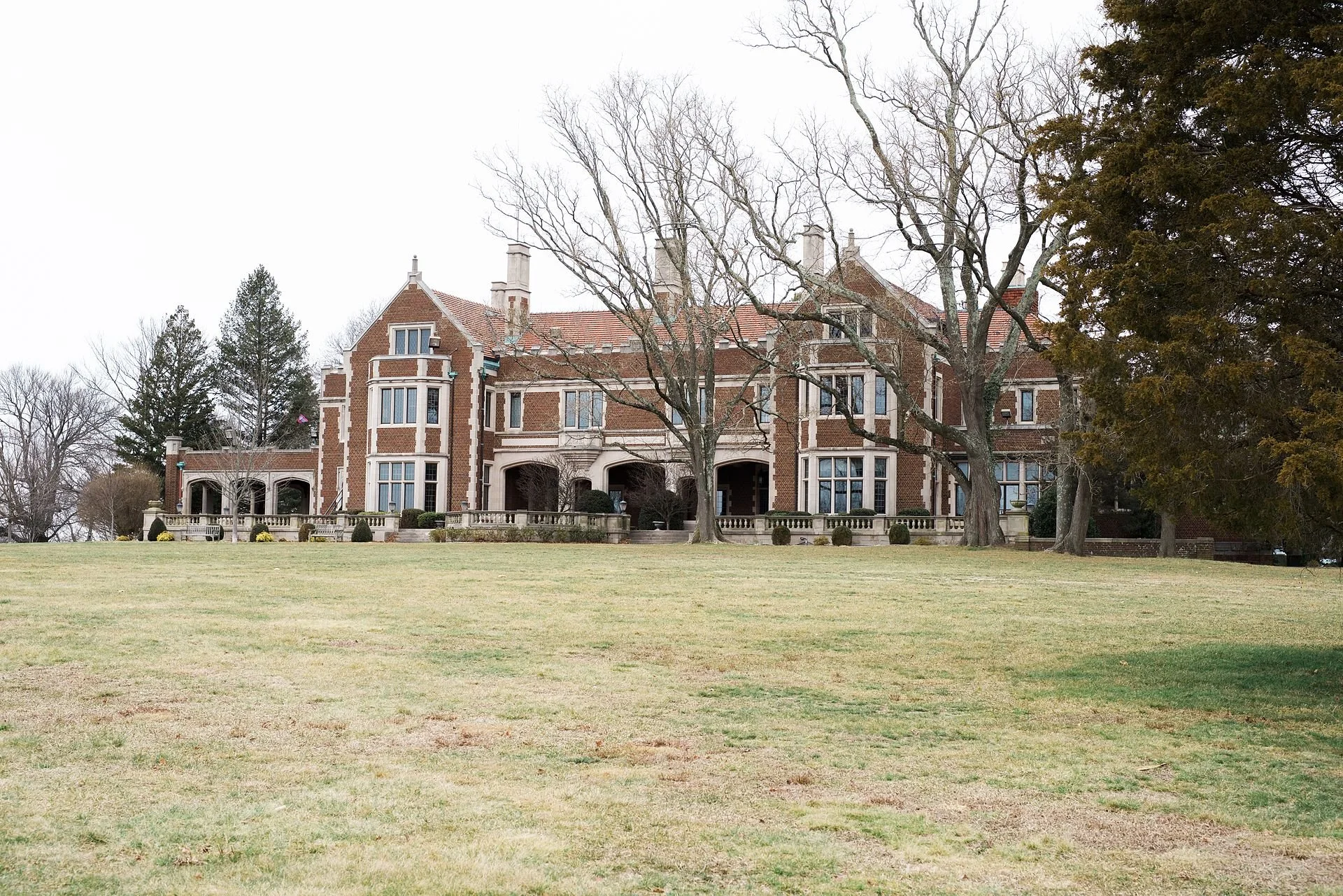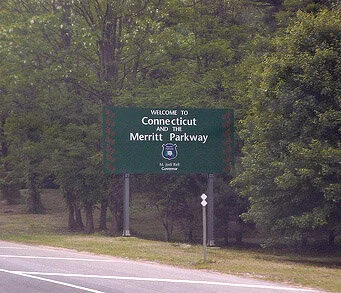
Don Pesci: In Arles: ‘We will take you’ to our ‘Gold Coast’
Aerial view of Arles. Note the Roman arena.
— Photo by Chensiyuan
VERNON, Conn.
Whenever French President Emmanuel Jean-Michel Frédéric Macron comes to mind, more often than I would wish, my remembrance floats back to a conversation we had with François, a boat owner in Arles more French than the Eiffel Tower and more emblematic of France than Macron.
François’s boat was parked on the Rhone just below our larger boat. My wife Andrée and I were leaning over the rail, about to descend on Arles, when he called up to us in communicable English.
“Where are you from? You are American.”
“Connecticut. This is my wife, Andrée.”
“Ah, French!”
“Her father was from Trois-Rivières, Quebec. She has Indian blood in her. The French and the Indians were on amicable terms, you may recall.”
“Yes.”
He would have said “yes” in any case, because he was in the process of selling his boat.
“Americans are rich, eh?”
“Not us,” my wife responded in French. “We’ve escaped that torture.”
François laughed, a hearty boatman’s laugh, no guile in it at all.
“You should come down here. I’d like to sell my boat to you.”
We declined the offer, but joined him on the dock where his boat was berthed. He brought us some wine and cheese from his boat.
“In Connecticut,” Andrée said, once again in French, “you are right to suspect that all the roads are paved with gold, especially in Fairfield County, where I was born and raised. This is the ‘Gold Coast’ of Connecticut, but we have no gold in our pockets to buy your beautiful boat.”
The boatman’s eyes glowed. Here was a woman who understood him.
“I will show you Arles.”
And he did.
When we left him, Andrée said to François, “You have been so kind to us. If ever you come to Connecticut, you must find us.” She gave him our address. “And when you come, we will take you to Fairfield {County}, where there are many rich people and many yachts. The people there would be interested in buying your beautiful boat.”
The three of us knew that we would never see each other again. Some kindnesses must remain unpaid. He lifted her slim fingers to his lips and we said our farewell to Arles.
Later that night, bunking in our own boat, traveling south on the Rhone through Provence to Nice, Andrée said, “I can still smell the wine of the region on my hand.”
Don Pesci is a Vernon-based columnist.
Waveny Mansion, in New Canaan, in the “Gold Coast’’ of Fairfield County, Conn.
— Photo by Karl Thomas Moore
Chris Powell: Mass transit can be tough to do in suburbia
Entering the Merritt Parkway, which serves mostly suburban Fairfield County.
Highway tolls aren't the only objection to Connecticut Gov. Ned Lamont's transportation-infrastructure plan. Now that the Democratic majority caucus in the state Senate seems to have blocked tolls for another year or two, there are also complaints about how the governor recommends spending whatever money still can be raised for transportation.
Some people say the governor mistakenly emphasizes highway widening over mass transit and that the "bottlenecks" he wants to remove can never be removed because "if you built it, they will come" -- that new traffic eventually will materialize to clog whatever highways are widened.
There is some truth to that, but it is not dispositive. For if increased traffic really should disqualify highway construction, the Boston Post Road, U.S. Route 1 northeast from New York, never could have been more than a footpath, never widened for wagons and paved, and the mail between the two cities forever would have had to be carried by boat through Long Island Sound and around Cape Cod.
Politically incorrect as it may be, population growth almost always will require road construction and widening, and it will always be a matter of judgment as to how much crowding and traffic signify too much growth.
Of course just as when you're a hammer, everything looks like a nail, when you're a roadbuilder everything looks like it needs paving, and most of the recent support for tolls in Connecticut came from construction businesses and labor unions that stood to receive most of the toll revenue and so were indifferent to which forms of transit might be best. Roadbuilding can get out of control, as it did in New York City in the 1950s and ‘60s during the tenure of the now-infamous parks, bridge, and tunnel commissioner Robert Moses, though the city, being so densely populated, was perfect for expanding mass transit. As a result ,construction of the Second Avenue subway line has been nearly a century behind schedule.
Today the transit dilemma identified by the governor's critics arises mostly where city and suburb meet -- where population density falls below the level needed to prevent mass transit from operating at an impossible deficit. Unfortunately, that's Connecticut for you -- largely suburban. Rebuilding the railroad line between Hartford and New Haven just cost the state and federal governments almost $800 million and each passenger's one-way trip incurs a grotesque operating cost of almost $60 even as the price of a ticket is only $8.
Mass transit works best where it is comprehensive -- where travelers don't need a car at either end of the line or where there is commuter parking at one end and the last leg of the trip is short. That is often the case in lower Fairfield and New Haven counties, along the Metro-North commuter railroad, the busiest such railroad in the country, but not in the rest of the state, which still needs roads more than rails.
Another complaint made lately in regard to tolls is that people in Connecticut think that highways should be free. But they don't really. Rather they are realizing that they have been paying for highways through fuel and related taxes while much of the revenue has been diverted to state employee pensions and other irrelevant purposes.
Connecticut could greatly reduce its transportation-infrastructure needs if it ever reduced poverty in its anarchic cities enough that middle-class people wanted to live there again. But maintaining poverty here is a bigger business than maintaining the roads and rails and it can't be questioned in polite company.
Chris Powell is a columnist for the Journal Inquirer, in Manchester, Conn.
Connecticut needs to fix its cities
Aetna's headquarters in Hartford, but not for long: The company is moving its home office to Manhattan.
Adapted from Robert Whitcomb's "Digital Diary,'' in GoLocal24.com:
Derek Thompson, writing in The Atlantic’s online service, has some interesting takes on Connecticut’s current fiscal problems. The state government has a huge deficit, some cities are effectively bankrupt, taxes are amongst the highest in the nation and some big companies have fled. And yet the state remains the richest on a per-capita basis in America, albeit largely because of New York City-connected rich folks living in Fairfield County. (Massachusetts is the second-richest; New Jersey the third.)
He notes some remarkably little reported reasons for the state’s ills: One is that Connecticut, like America in general, has lost much of its high-valued manufacturing, a sector for which Connecticut was once famed around the world. (I lived near Waterbury for four years in the early and mid-‘60s, from when I well remember the busy factories up and down the colorfully polluted Naugatuck River.)
Very highly paid people in finance, many of them commuting to Manhattan but many doing their thing in Stamford and Greenwich, have offset some of this loss. However, finance, which of course follows the ups and downs of Wall Street, is more cyclical than manufacturing. And the latter provided a wider range of well-paying jobs to many more people than does finance.
Another important change that Mr. Thompson cited is that the big cities close to Connecticut --- especially New York and Boston – have become much safer and more attractive. Rich people and Millennials have been moving back into them, having grown bored with suburbs, even those as attractively sylvan as some on Connecticut’s strip of the Long Island Sound shoreline.
Conservatives who seem obsessed with high taxes above all else should note that some of the big companies pulling their headquarters from Connecticut are not exactly moving to low-tax venues. Consider that Aetna is leaving Hartford for Manhattan and General Electric has left Fairfield for Boston. They want the dynamism of those cities and are happy to pay for it.
The Nutmeg State has poor, high-crime and often badly run cities. If the state is to improve its long-term prospects, I and Mr. Thompson would agree, it needs to fix its cities. Hartford, which used to be a vibrant and mostly middle-class city before bad municipal government, ill-considered“ urban renewal’’ and other factors drove it into the ditch, is expected to go into official bankruptcy soon. That should let it start cleaning up its act and make it a place that people, especially young adults who might otherwise go to New York, would want to live and work in. That could help turn around the whole state. After all, Hartford is the state capital.
Border-jumping cougars in N.E.
 ---- U.S. Fish and Wildlife Service photo
---- U.S. Fish and Wildlife Service photo
By BILL BETTY for ecoRI News
Sue Morse is an expert in natural history and one of the top wildlife trackers in North America. A recent article about her caught my attention. She believes the northern counties in Vermont, New Hampshire, Maine and New York would be ideal places for migrating cougars to reoccupy. These areas have what pumas need to survive: prey, open space and cover.
Morse, the founder of Keeping Track, believes that South Dakota cougars will spread to Manitoba and then to Ontario. Their descendants will eventually reach New England.
Besides Ontario, it’s likely the origins of these recruits to New England will be from Quebec and the Maritime Provinces. Mountain lions have already been identified there. Ontario has them as well, and Morse’s Manitoba trekkers will only add to the number of free-ranging North American genotype cougars now found in the province. Since all North American subspecies are virtually indistinguishable, this will hardly make any difference in their genetic makeup. And we’ll still call them eastern cougars no matter what anyone says.
The Ontario Puma Foundation has estimated the number of mountain lions at 550. One has been shot, another captured and about 24 confirmations have been made. Nearly 500 pieces of evidence have been recovered. Despite this, obstructionists continue to issue denials, suggesting that all of these cougars are males — hence no natural reproduction.
Studies by Marc Gauthier and Anne-Sophie Bertrand during the past two decades have confirmed 19 mountain lions in New Brunswick and Quebec. Gauthier’s latest estimate of an existing population in Quebec is 10 to 100 pumas. Three mountain lions have been killed in Quebec, including a lactating female cougar that was hit by a truck near the New Hampshire border.
Advocates who favor restocking the Northeast by releasing Western cats into the region reject any suggestion that natural reproduction is taking place in the East because it undermines their raison d'être.
Five Nova Scotia events would be categorized as “class II” discoveries elsewhere, including the 1986 incident where the Bower family carried an unconscious cougar to the side of the road — similar incidents have happened in New England. Nova Scotia officials have classified this knockdown as “virtually certain.”
In addition, a number of provincial employees, including the head of the province’s Endangered Species Division, have reported sightings or found evidence.
In short, what we have sitting across the Canadian border is Montana is an enormous tract four times the size of Texas where mountain lions are present in sufficient numbers to persist. If pumas can drift down here from Ontario, they can just as easily wander into northern New England from Quebec, New Brunswick and Nova Scotia.
Many dispersers from eastern Canada will not go very far and will end up establishing home ranges nearby, but a few of these young cats will head south and trickle into New England. For a mountain lion, the Northeast is a hop, skip and a jump from New Brunswick, Quebec, Nova Scotia and Ontario, as opposed to the Black Hills, which are 1,800 miles away and a 22-month cat walk.
Morse and I hold similar views on this subject. Eastern Canadian migration is, in fact, what I have been suggesting for the past decade. She believes this dispersal of cougars to New England and New York may take as long as 30 years for a breeding population to return. Judging by the number of reports recorded and the evidence collected in the Northeast, it’s my view that this migration has been ongoing for decades. It’s possible that we already have a number of mountain lions in New England with ancestry from Quebec or nearby provinces. Others here may be from Michigan and other Midwest states.
Northern New York, New Hampshire, Maine and Vermont have brutal winters, deep snow and the lowest deer population in the Northeast. If Morse believes that these are ideal are conditions for puma, then what about Spencer, Mass., Pomfret, Conn., or Stanford, N.Y.? They all have relatively moderate weather, less snow, more deer and plenty of open space. These places also have farms, gardens and orchards. It’s where people have chosen to live, and now mountain lions are being seen there.
Maurice Hornocker, the dean of mountain lion researchers, has a simple theory that explains the urban cougar phenomenon. He believes “people attract deer” by providing food for them in the form of flowers, vegetables, fruits trees and the like, and the “deer in turn attract cougars.” Hornocker told me that he thought cougars would “start showing up in New England.”
Much of the evidence confirming lions has been discovered near settled areas. In 2011, a cougar was road killed on the Merritt Parkway, which runs through Connecticut’s Fairfield County. A million people live there. So do 30,000 deer. Pumas have been discovered in places such as Greenwich, Conn. Cougars of the Valley, a nonprofit based in Canton, Conn., has enlisted the help of local houndsmen to locate cougars using specially trained scat dogs.
Michael Keveny at Clark University analyzed potential sites for cougar reoccupation in Massachusetts and concluded that many parts of the state had adequate habitat for pumas to survive. Some like Cape Cod and Bristol County, Mass., he considered the “best.” Sport hunting zones around Boston have kill totals that are five times higher than those from the state’s three western counties.
In New York State, it’s much of the same story. John Laundre has identified the Adirondacks as a potential site for cougar reoccupation. He believes that the area could support as many as 390 pumas. Western New York could support a lot more. Deer kills in some southern and western New York counties, for example, are more than 10 times higher than in the Adirondacks. With a million whitetails, New York is a fertile hunting ground for apex predators.
Maine’s highest deer harvest was reported in the Midcoast region, where many of the state’s residents live. Deer kills in these five districts far exceed those from the interior. In fact, 100 northern townships had zero sport hunting kills last year. One person who presumably is watching all of this is Nathan Webb, a carnivore specialist and mountain lion expert with Maine’s Department of Inland Fisheries & Wildlife, who was recruited from Alberta, Canada.
If Burlington, Vt., and Lake Placid, N.Y., are ideal habitat for mountain lions in Morse’s opinion, then the towns and cities in New England and Atlantic Canada surely meet the definition of cougar heaven. There have been reported sightings of large cats in Rhode Island. The urban/woodland interface on the outskirts of coastal settlements have everything that mountain lions need to survive: numerous whitetails, small mammals, song birds and waterfowl; adequate edge habitat in the form of fields and clearings; and abundant patches of woods and brush that provide excellent cover.
Ontario dispersers will show up in New England or New York at some point if they haven’t already. It’s possible some of the recruits that establish home ranges in the Northeast will be migrators from Nova Scotia, Quebec or New Brunswick. A few that pass through northern New England will probably continue on to more hospitable places such as New Milford, Conn., or Rochester, Mass. Their arrival will not go unnoticed by other members of their species.
Alan Rabinowitz, CEO of Panthera, lives in Connecticut. He believes there is a small population in the region that is maintaining itself and breeding. He doesn’t accept the explanation that every cougar wandering the edges of suburbia is a former pet that managed to escape. If he’s right, then some local mountain lions must be border jumpers that found their way to southern New England from their natal ranges in eastern Canada by following rivers or hugging the coast.
We should celebrate the arrival of mountain lions in New England. Vermont has done so by putting the face of a catamount on its license plate. The Massachusetts Division of Fisheries & Wildlife has taken a step in the right direction by stating that “a large cat would be safeguarded under state statute — a welcome visitor, like any other indigenous animal (other than threat situations).”
Acknowledgement of mountain lions in their jurisdictions will be the next step for all of the New England wildlife agencies. I’m not optimistic that it will happen soon. Some states have sent officers to tracking schools in Wyoming or exchanged personnel with western states to learn firsthand about pumas. Others have circled the wagons. Money and manpower are issues.
The odds of this apex predator surviving and reproducing along the coast in Maine, Connecticut and Rhode Island or in the rolling hills in southern Vermont or New Hampshire are much better than in the hinterlands of New England. Abundant resources make these locations a predator’s paradise. And you don’t have to be one of the puma illuminati to figure this out.
Bill Betty is a Richmond, R.I., resident.




